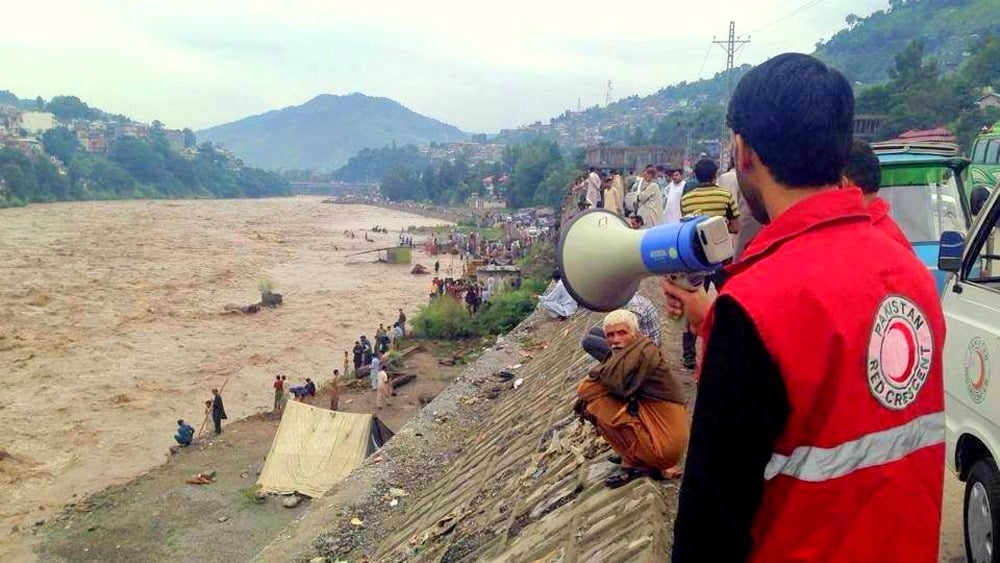The National Disaster Management Authority (NDMA) reports that more than 200 people have died since the flooding began in early September, with some 1,200 villages submerged so far, affecting 600,000 people. Thousands of homes have been destroyed, while almost 436,000 acres (176,443 hectares) of crops have been lost. The figures are rising daily.
“The biggest immediate challenge is to get people out of the inundated areas and to relief camps - then meeting their needs for shelter, food and water,” NDMA spokesman Ahmad Kamal told IRIN. Access to affected people is difficult owing to the sheer scale of the disaster.
The mountainous northern regions of Gilgit-Baltistan and Pakistani-administered Kashmir have already seen significant flood devastation: Scores of villages have been submerged and thousands of people displaced. Landslides and collapsing infrastructure, including thousands of homes, have claimed dozens of lives.
Swollen rivers flowing south from the mountains into Punjab, the country’s most populated province, have started to breach flood defences, unleashing further devastation as huge volumes of water surge into agricultural heartlands.
But it is not just farmland close to the rivers which has been affected. Parts of the provincial capital, Lahore, are under water, as is the nearby city of Wazirabad. Punjab declared a state of emergency a few days ago.
The NDMA and its counterparts at provincial and district levels are working jointly with the Pakistani armed forces, leading rescue efforts in which more than 2,300 troops and dozens of boats have been deployed, with helicopter support.
The immediate needs are search and rescue, restoration of access, drainage, food, drinking water, and emergency health and shelter requirements for the growing number of flood displaced people in the 271 camps dotted across Punjab.
“As reports are still coming in, the picture will only be clearer in the next couple of days,” said Ghulam Muhammad Awan, director of operations for the Pakistan Red Crescent Society. “At this point in time, with the knowledge that flooding is expected in Sindh in the next few days, it is anticipated that this is a disaster that will figure between the flooding of 2013 which affected about 1.5 million people and the super floods of 2010 which affected some 20 million people.”
Some positives
But the crisis had shown a number of positives. “Better capacity and systems to cope with flooding, along with earlier evacuation have saved people’s lives,” Kamal said, praising the efforts of local authorities and army rescue teams. Tens of thousands of people were evacuated ahead of the floods.
Meanwhile, rising water continues to put pressure on the Trimu Headworks (a barrage system of sluices designed to control the flow of water), where the rivers Jhelum and Chenab meet near the city of Jhang, in central Punjab. Thousands of families are in the process of being evacuated from the surrounding area. Parts of Punjab are already three metres under water.
Describing the ongoing flood situation as an “evolving crisis”, Annette Hearns, acting head of the UN Office for the Coordination of Humanitarian Affairs (OCHA) in Pakistan, said: “We are monitoring the situation very closely and are in constant contact with the respective local and national government authorities.”
“An exceptionally high volume of water is moving south, through Punjab, and will converge at various points in the next few days. As the water moves, the impact of the situation will evolve,” she said.
She praised the actions of the authorities leading rescue and relief activities, acknowledging that lessons learned from wide-scale flooding in 2010, and investment in Disaster Risk Reduction (DRR), had paid dividends.
“Earlier evacuation of those at risk has been apparent, with effective early warning systems and experience from previous wide-scale flooding playing a part in saving people’s lives and safeguarding their assets,” she said.
The government has not made a formal request for assistance to the international humanitarian community.
Sindh
The southern province of Sindh is on high alert, with the flood surge set to reach the region by the weekend. (Balochistan and Khyber Pakhtunkhwa – two of the country’s four provinces - are outside the major flooding zones).
Sources within the humanitarian community say worst-case scenarios envisage the number of those affected potentially running into many millions. The Pakistan Meteorological Department says more rain is likely. The next few days will be critical.
Meanwhile, the Pakistan Humanitarian Forum (PHF), which supports and represents more than 50 international NGOs in the country, said its members were mobilized and ready to respond, as required.
A PHF spokesperson said many of its members were already on the ground engaged in other projects: 27 organisations in Punjab; 12 in Pakistani-administered Kashmir; and 36 in Sindh.
“Some members are already responding in Punjab and Kashmir, initiating a Non-Food Item response, while in Sindh the DRR phone chains have been started to warn beneficiaries about the potential for rising waters, where [PHF] members are collaborating with local authorities as required.”
ag/jj/cb
This article was produced by IRIN News while it was part of the United Nations Office for the Coordination of Humanitarian Affairs. Please send queries on copyright or liability to the UN. For more information: https://shop.un.org/rights-permissions





